by Bruce Wells | Mar 3, 2025 | This Week in Petroleum History
March 3, 1879 – United States Geological Survey established –
President Rutherford B. Hayes signed legislation creating the United States Geological Survey (USGS) within the Department of the Interior. The legislation resulted from a report by the National Academy of Sciences, which had been asked by Congress to provide a plan for surveying the country.

Original logo for the U.S. Geological Survey and the current one. The motto “science for a changing world” was added in 1997.
The new agency’s mission included “classification of the public lands, and examination of the geological structure, mineral resources, and products of the national domain,” according to USGS, which since 1974 has been headquartered on a 105-acre site in Reston, Virginia. USGS maintains the world’s largest library collection dedicated to earth and natural sciences, including more than one million books, 600,000 maps, and 500,000 photographs.
March 3, 1886 – Natural Gas brings light to Paola, Kansas
Paola became the first town in Kansas to use natural gas commercially for illumination. To promote its natural gas resources and attract businesses from nearby Kansas City, civic leaders erected four flambeaux arches in the town square. Pipes were laid for other illuminated displays.

“Pearl Street Looking South, Paola, Kansas” is among images preserved by the Miami County Kansas Historical Society & Museum. An annual Paola Roots Festival began in 1990.
“Paola was lighted with Gas,” proclaimed an exhibit at the Miami County Historical Museum. “The pipeline was completed from the Westfall farm to the square and a grand illumination was held.” By the end of 1887, several Kansas flour mills were fueled by natural gas. Paola’s gas wells would run dry, but more mid-continent oil discoveries would follow
March 4, 1918 – West Virginia Well sets World Depth Record
Hope Natural Gas Company completed an oil well at a depth of 7,386 feet on the Martha Goff farm in Harrison County, West Virginia. The cable-tool well became the world’s deepest until surpassed by a 1919 well in nearby Marion County. The previous world record had been a well in Germany at 7,345 feet.
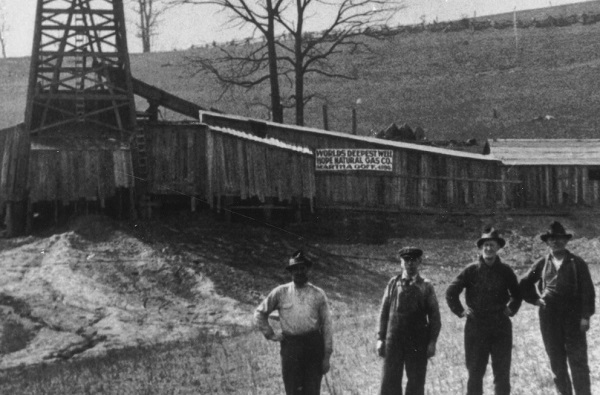
Drilled with cable-tools near Clarksburg, this 1918 West Virginia well was the world’s deepest until one drilled in a neighboring county. Photo courtesy West Virginia Oil and Natural Gas Association.
In 1953, the New York State Natural Gas Corporation claimed the world’s deepest cable-tool well at a depth of 11,145 feet at Van Etten, New York. A rotary rig depth record was set in 1974 by the Bertha Rogers No. 1 well at 31,441 feet, and a Soviet Union experimental well in 1989 reached 40,230 feet — the current world record.

March 4, 1933 – Oklahoma City Oilfield under Martial Law
Oklahoma Governor William H. “Alfalfa Bill” Murray declared martial law to enforce his regulations strictly limiting production in the Oklahoma City oilfield, discovered in December 1928. Two years earlier, Murray had called a meeting of fellow governors from Texas, Kansas and New Mexico to create an Oil States Advisory Committee, “to study the present distressed condition of the petroleum industry.”

William “Alfalfa Bill” Murray in 1932.
Elected in 1930, the controversial politician was called “Alfalfa Bill” because of speeches urging farmers to plant alfalfa to restore nitrogen to the soil. By the end of his administration, Murray had called out the National Guard 47 times and declared martial law more than 30 times. He was succeeded as Oklahoma governor by E.W. Marland in 1935.
March 4, 1938 – Giant Oilfield discovery in Arkansas
The Kerr-Lynn Oil Company (a Kerr-McGee predecessor) completed its Barnett No. 1 well east of Magnolia, Arkansas, discovering the giant Magnolia oilfield, which would become the largest producing field (in volume) during the early years of World War II, helping to fuel the American war effort.

Crew members stand in front of their 1938 giant oilfield discovery well at Magnolia, Arkansas. Photo courtesy W.B. “Buzz” Sawyer.
The southern Arkansas gusher launched a Columbia County oil boom similar to Union County’s Busey-Armstrong No. 1 well southwest of El Dorado in January 1921 (see First Arkansas Oil Wells).
March 5, 1895 – First Wyoming Refinery produces Lubricants
Near the Chicago & North Western railroad tracks in Casper, Civil War veteran Philip “Mark” Shannon and his Pennsylvania investors opened Wyoming’s first refinery. It could produce 100 barrels a day of 15 different grades of lubricant, from “light cylinder oil” to heavy grease. Shannon and his associates incorporated as Pennsylvania Oil and Gas Company.
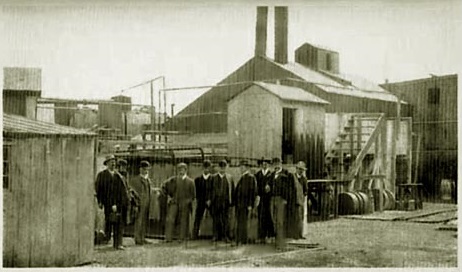
The original Casper oil refinery in Wyoming, circa 1895. Photo courtesy Wyoming Tales and Trails.
By 1904, Shannon’s company owned 14 wells in the Salt Creek field, about 45 miles from the company’s refinery (two days by wagon). Each well produced up to 40 barrels of oil per day, but transportation costs meant Wyoming oil could not compete for eastern markets. The state’s first petroleum boom began in 1908 with Salt Creek’s “Big Dutch” well.
Learn more in First Wyoming Oil Wells.

March 6, 1935 – Search for First Utah Oil proves Deadly
More than a decade before Utah’s first commercial oil wells, residents of St. George had hoped the “shooting” of a well drilled by Arrowhead Petroleum Company would bring black gold prosperity. A crowd had gathered to watch as workers prepared six, 10-foot-long explosive canisters to fracture the 3,200-foot-deep Escalante No. 1 well.

The Escalante well heralded new prosperity for residents of nearby St. George, Utah, in 1935 — until an attempt to shoot the well went wrong and canisters of TNT and nitroglycerin exploded. Photo courtesy Washington County Historical Society.
An explosion occurred as the torpedoes, “each loaded with nitroglycerin and TNT and hanging from the derrick,” were being lowered into the well. Ten people died from the detonations, which “sent a shaft of fire into the night that was seen as far as 18 miles away.”
The 1935 accident has remained the worst oil-related disaster in Utah, according to The Escalante Well Incident, a 2007 historical account.
March 6, 1981 — Shale Revolution begins in North Texas
Mitchell Energy and Development Corporation drilled its C.W. Slay No. 1 well, the first commercial natural gas well of the Barnett shale formation. Over the next four years, the vertical well in North Texas produced nearly a billion cubic feet of gas, but it would take almost two decades to perfect cost-effective shale fracturing methods combined with horizontal drilling.
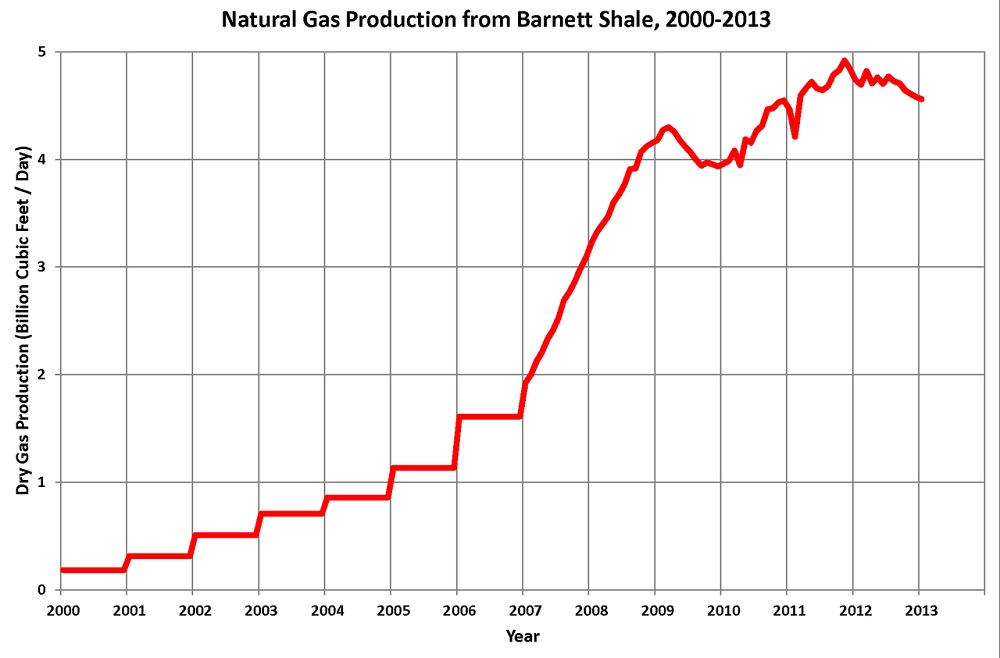
Production from the Barnett shale formation extends from Dallas west and south, covering 5,000 square miles, according to the Texas Railroad Commission. Chart courtesy Dan Plazak.
Mitchell Energy’s 7,500-foot-deep well and others in Wise County helped evaluate seismic and fracturing data to understand deep shale structures. “The C.W. Slay No. 1 and the subsequent wells drilled into the Barnett formation laid the foundation for the shale revolution, proving that natural gas could be extracted from the dense, black rock thousands of feet underground,” the Dallas Morning News later declared.
By the end of 2012, with almost 14,000 wells drilled in the largest gas field in Texas, production started to decline, but the Barnett field still accounted for 6.1 percent of Texas natural gas production and 1.8 percent of the U.S. supply, according to the Federal Reserve Bank of Dallas.
March 7, 1902 – Oil discovered at Sour Lake, Texas
Adding to the giant oilfields of Texas, the Sour Lake field was discovered about 20 miles west of the world-famous Spindletop gusher of January 1901. The spa town of Sour Lake quickly became a boom town where major oil companies, including Texaco, got their start.
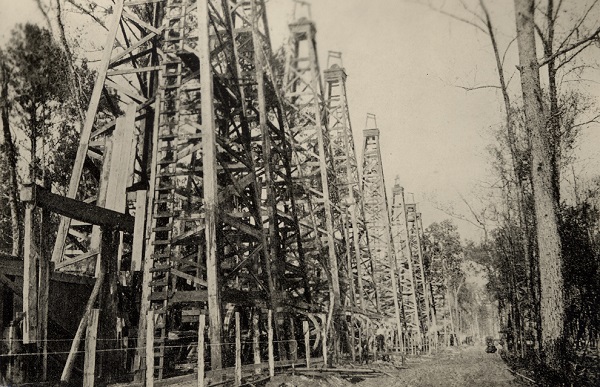
“The resort town of Sour Lake, 20 miles northwest of Beaumont, was transformed into an oil boom town when a gusher was hit in 1902,” notes the Texas State Library and Archives Commission.
Originally settled in 1835 and called Sour Lake Springs because of its “sulphureus spring water” known for healing, the sulfur wells attracted many exploration companies. Some petroleum geologists predicted a Sour Lake salt dome formation similar to that revealed by Pattillo Higgins, the Prophet of Spindletop.
Sour Lake’s 1902 discovery well was the second attempt of the Great Western Company. The well, drilled “north of the old hotel building,” penetrated 40 feet of oil sands before reaching a total depth of about 700 feet. The Hardin County’s salt dome oilfield yielded almost nine million barrels of oil by 1903, when the Texas Company made its first major oil find at Sour Lake.
Learn more in Sour Lake produces Texaco.

March 7, 2007 – National Artificial Reef Plan updated
The National Marine Fisheries Service of the National Oceanic and Atmospheric Administration (NOAA), approved a comprehensive update of the 1985 National Artificial Reef Plan, popularly known as the “rigs to reefs” program.

A typical platform provides almost three acres of feeding habitat for thousands of species. Photo courtesy U.S. Bureau of Safety and Environmental Enforcement.
The agency worked with interstate marine commissions and state artificial reef programs, “to promote and facilitate responsible and effective artificial reef use based on the best scientific information available.” The revised National Artificial Reef Plan included guidelines for converting old platforms into reefs. A typical four-leg structure provides up to three acres of habitat for hundreds of marine species.
“As of December 2021, 573 platforms previously installed on the U.S. Outer Continental Shelf have been reefed in the Gulf of Mexico,” according to the Bureau of Safety and Environmental Enforcement (BSEE).
Learn more in Rigs to Reefs.
March 9, 1930 – Prototype Oil Tanker is Electrically Welded
The world’s first electrically welded commercial vessel, the Texas Company (later Texaco) tanker M/S Carolinian, was completed in Charleston, South Carolina. The World War I shipbuilding boom encouraged new electric welding technologies. The oil company’s 226-ton vessel was a prototype designed by naval architect Richard Smith.

Construction of M/S Carolinian began in 1929. The M/S designation meant it used an internal combustion engine. Photo courtesy Z.P. Liollio.
The tanker — the first electrically welded ship — eliminated the need for about 85,000 pounds of rivets, according to a 2017 article for the International Committee for the Conservation of the Industrial Heritage (TICCIH). Success of the prototype led to “the standard of welded hulls and internal combustion engines would become universal in construction of new vessels.”

March 9, 1959 – Barbie is a Petroleum Doll
Mattel revealed the Barbie Doll at the American Toy Fair in New York City. More than one billion “dolls in the Barbie family” have been sold since. Eleven inches tall, Barbie owes her existence to petroleum products and the science of polymerization, including several plastic acronyms: ABS, EVA, PBT, and PVC.

Petroleum-based polymers are part of Barbie’s DNA.
Acrylonitrile-Butadiene-Styrene (ABS) is known for strength and flexibility. This thermoplastic polymer is used in Barbie’s torso to provide impact and heat resistance. EVA (Ethylene-Vinyl Acetate), a copolymer made up of ethylene and vinyl acetate, protects Barbie’s smooth surface.
The Mattel doll also includes Polybutylene Terephthalate (PBT), a thermoplastic polymer often used as an electrical insulator. A mineral component facilitates PBT injection molding of her “full figure,” according to the company. Barbie’s hair and many of her designer outfits are made from the world’s first synthetic fiber, nylon, invented in 1935 (see Nylon, a Petroleum Polymer and more articles in Petroleum Products).
_______________________
Recommended Reading: Trek of the Oil Finders: A History of Exploration for Petroleum (1975); History of Paola, Kansas (1956); Where it all began: The story of the people and places where the oil & gas industry began: West Virginia and southeastern Ohio
(1956); Where it all began: The story of the people and places where the oil & gas industry began: West Virginia and southeastern Ohio (1994); Oil And Gas In Oklahoma: Petroleum Geology In Oklahoma
(1994); Oil And Gas In Oklahoma: Petroleum Geology In Oklahoma (2013); Kettles and Crackers – A History of Wyoming Oil Refineries
(2013); Kettles and Crackers – A History of Wyoming Oil Refineries (2016); Utah Oil Shale: Science, Technology, and Policy Perspectives
(2016); Utah Oil Shale: Science, Technology, and Policy Perspectives (2016); George P. Mitchell: Fracking, Sustainability, and an Unorthodox Quest to Save the Planet (2019); Sour Lake, Texas: From Mud Baths to Millionaires, 1835-1909
(2016); George P. Mitchell: Fracking, Sustainability, and an Unorthodox Quest to Save the Planet (2019); Sour Lake, Texas: From Mud Baths to Millionaires, 1835-1909 (1995); Rigs-to-reefs: the use of obsolete petroleum structures as artificial reefs
(1995); Rigs-to-reefs: the use of obsolete petroleum structures as artificial reefs (1987); Plastic: The Making of a Synthetic Century Hardcover
(1987); Plastic: The Making of a Synthetic Century Hardcover (1996); American Fads
(1996); American Fads (1985). Your Amazon purchase benefits the American Oil & Gas Historical Society. As an Amazon Associate, AOGHS earns a commission from qualifying purchases.
(1985). Your Amazon purchase benefits the American Oil & Gas Historical Society. As an Amazon Associate, AOGHS earns a commission from qualifying purchases.
_______________________
The American Oil & Gas Historical Society (AOGHS) preserves U.S. petroleum history. Please become an AOGHS annual supporter and help maintain this energy education website and expand historical research. For more information, contact bawells@aoghs.org. Copyright © 2025 Bruce A. Wells. All rights reserved.
by Bruce Wells | Feb 25, 2025 | Petroleum Pioneers
A popular 1837 book by Washington Irving helped reveal natural resources of the Far West.
Tales of a Wyoming “tar spring” convinced the experienced Pennsylvania oilfield explorer Mike Murphy to drill a shallow well in 1883. He sold his oil to Union Pacific to lubricate train axles. Others would follow in the search for Wyoming oilfields.
Civil War veteran Philip Shannon explored for oil at Salt Creek outside of Casper in 1890. His well revealed what proved to be a 22,000-acre oilfield. An oil gusher drilled by a Dutch company made headlines in 1908.
But the story of Wyoming’s petroleum really began with Washington Irving, author of “The Legend of Sleepy Hollow.” (more…)
by Bruce Wells | Jan 30, 2025 | Petroleum History Almanac
Col. William F. Cody searched for Wyoming black gold.
Col. William F. “Buffalo Bill” Cody’s legacy extends beyond his famous Wild West show. A Wyoming town named Cody preserves his Big Horn Basin heritage, but less known is his adventure into the oil business.
“Buffalo Bill’s Wild West and Congress of Rough Riders of the World” once made W.F. Cody the most recognized man in the world. His fanciful Indian attacks on wagon trains, the marksmanship by Annie Oakley, and other attractions drew audiences in America and Europe. (more…)
by Bruce Wells | Jan 14, 2025 | Petroleum Companies
Wildly optimistic promotions during WWI and some drilling, but no gushers.
“Oil Excitement at Rocky Ford Field Near Sundance,” proclaimed a front page of the Moorcroft (Wyoming) Democrat on September 14, 1917, describing a “big drill” of the Wyoming-Dakota Company.
“Rocky Ford, the seat of the oil activities in Crook county is about the busiest place around,” the newspaper continued. “Cars come and go, people congregate and the steady churning of the two big rigs continues perpetually.”
Not finished with its excited reporting, the Moorcroft Democrat noted: “Excitement has reached the zenith of tension, and with each gush of the precious fluid, oil stock climbs another notch. The big drill of the Wyoming-Dakota Co. has been pulled from their deep hole until spring. The drill reached 600 feet and was in oil.”
The Rapid City, South Dakota, oil exploration company — reported to have one producing well and three more drilling — was capitalized $500,000 with a nominal par value of 25 cents per share. All the leases were in Crook County and included 3,200 acres in Lime Butte field; 10,000 acres in Rocky Ford field; and 4,000 acres in Poison Creek field.
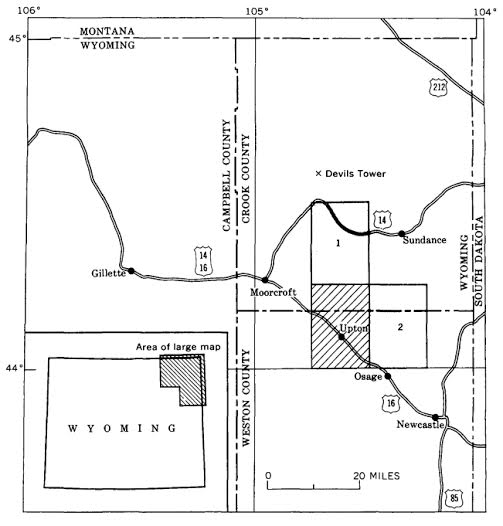 Since Wyoming would not pass its first “Blue Sky” to prevent fraudulent promotions until 1919, Wyoming-Dakota Oil’s newspaper ads often rivaled patent medicine exaggerations. For example, one ad noted “geologists claim this showing indicates alone 500,000 barrels to the acre.”
Since Wyoming would not pass its first “Blue Sky” to prevent fraudulent promotions until 1919, Wyoming-Dakota Oil’s newspaper ads often rivaled patent medicine exaggerations. For example, one ad noted “geologists claim this showing indicates alone 500,000 barrels to the acre.”
Wyoming-Dakota Oil further enticed investors with, “Your Chance Has Come if you want to make money in Oil.” In Sioux Falls, South Dakota, the Sells Investment Company offered Wyoming-Dakota Oil Company stock reportedly after “a careful selection of conservative issues from among the thousand prospects, offering same to you before higher prices prevail or its present substantial position has been discounted by professional traders. A good clean cut speculation of this character may mean a fortune. Watch this company for sensational developments.”
The United States had entered World War I in April 1917; by November newspapers reported Francis Peabody, chairman of the Coal Committee of the Council of National Defense, was telling the U.S. Senate Public Lands Committee that the country was not producing enough oil to win the war.
“He said if nothing were done to develop new wells the reserve supply would he exhausted in twelve months and production would be 50,000,000 barrels less than requirements,” one newspaper noted. Wyoming-Dakota Oil Company executives took advantage of the opportunity.
“The (war) situation outlined leads us to suggest that you investigate Wyoming-Dakota Oil. ‘We are doing our bit’ by drilling night and day. Ours is an investment worth while. The allotment of Treasury stock at 25 cents is almost sold out and the Directors will advance the price of stock to 50 cents a share (100 per cent on your present investment) on December 15th, 1917.”

The Wyoming-Dakota Oil promotion continued: “By that time our newspaper announcement in the Eastern cities, pointing out the enormous acreage, present production and negotiations for additional valuable holdings will be made known to millions of seasoned investors in New York, Philadelphia, Chicago, Boston and Pittsburgh. We feel confident this will result in a demand for this stock that will send the present market price skyward. We trust you will see the wisdom of prompt action before all available stock at 25 cents per share has been purchased by other investors.”
In early 1918, Wyoming-Dakota Oil Company had drilled wells in the Upton-Thornton oilfield and was “holding out high hope of bringing in a gusher in few days.” In July, the Laramie Daily Boomerang reported the company had “two rigs going steadily in Crook County’s Rocky Ford field” — but no oil gushers
Growing investor pessimism was reflected in Wyoming-Dakota Oil Company’s stock prices, which fell in over-the-counter markets from 75 cents bid in June 1919 to 50 cents bid at the end of September. By March 1920, brokers offered 5,000 shares or any part thereof at 5 cents a share.
A final blow to the company was reported in the Laramie Republican of July 25, 1921: “Wyoming-Dakota…has completed pulling the casing from the well which it has been drilling north of town, after having struck a formation said to be granite, at a depth of 715 feet,”
The Laramie newspaper remained optimistic. “While this has a tendency to retard the activities of other interests, it is by no means stopping them entirely and it is to be hoped that another well will be started this summer.”
That did not happen. Reports on Wyoming-Dakota Oil Company disappeared for the next 24 years, until a court summons was published in the January 25, 1945, Sundance (Wyoming) Times. The summons said Wyoming-Dakota Oil — address or place of residence to plaintiff unknown — was being sued in the Sixth District Court of Wyoming.
The world war-inspired oil exploration company has since faded into history, and its stock certificates are valued only by scripophily collectors. For the true story behind a Texas oilfield that played a vital role in the “War to End All Wars,” see Roaring Ranger wins WWI.
_______________________
The American Oil & Gas Historical Society (AOGHS) preserves U.S. petroleum history. Please become an AOGHS annual supporter and help maintain this energy education website and expand historical research. For more information, contact bawells@aoghs.org. Copyright © 2025 Bruce A. Wells.
Citation Information: Article Title – “Wyoming-Dakota Company” Authors: B.A. Wells and K.L. Wells. Website Name: American Oil & Gas Historical Society. URL https://aoghs.org/old-oil-stocks/wyoming-dakota-oil-company. Last Updated: March 31, 2025. Original Published Date: January 14, 2016.
by Bruce Wells | Oct 21, 2024 | This Week in Petroleum History
October 21, 1921 – First Natural Gas Well in New Mexico –
The New Mexico natural gas industry began when the newly established Aztec Oil Syndicate’s State No. 1 well found a gas field about 15 miles northeast of Farmington in San Juan County. The drilling crew used a tree trunk with a two-inch pipe and shut-off valve to control the well until a wellhead could be shipped from Colorado. The well produced 10 million cubic feet of natural gas a day.
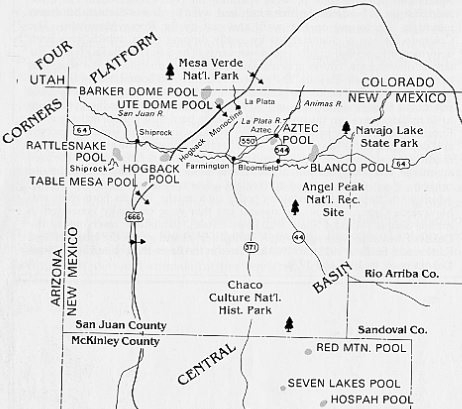
New Mexico’s first commercial natural gas service began after a 1921 discovery near Aztec. Oil discoveries followed in the southeast.
By the end of December 1921, a pipeline reached two miles into the town of Aztec, where citizens enjoyed New Mexico’s first commercial natural gas service. In 1922, natural gas could be purchased in Aztec at a flat rate of $2 a month (for a gas heater) and $2.25 (for a gas stove). Learn more about the state’s petroleum history in First New Mexico Oil Wells.

October 23, 1908 – Salt Creek Well launches Wyoming Boom
Wyoming’s first oil boom began when the Dutch company Petroleum Maatschappij Salt Creek completed its “Big Dutch” well about 40 miles north of Casper.
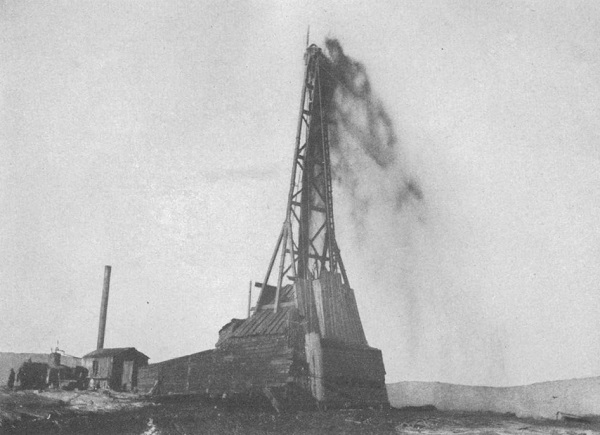
The “Big Dutch” No. 1 well, above, launched a Wyoming drilling boom in 1908. Photo courtesy U.S. Geological Survey.
Salt Creek’s potential had been known since the 1880s, but the area’s central geological salt dome received little attention until Italian geologist Cesare Porro recommended drilling there in 1906. Another salt dome formation had been revealed with the 1901 Spindletop oilfield discovery in Texas.
At Salt Creek, the Oil Wells Drilling Syndicate, a British company, drilled the “Big Dutch” well, which produced 600 barrels of oil a day from a depth of 1,050 feet deep and launched a Wyoming drilling boom. By 1930, about one-fifth of all U.S. oil came from the Salt Creek oilfield. Production continued in the 1960s with water-flooding technologies and the use of carbon dioxide injection beginning in 2004.
Learn more in First Wyoming Oil Wells.

October 23, 1948 – “Smart Pig” advances Pipeline Inspection
Northern Natural Gas Company recorded the first use of an X-ray machine for internal testing of petroleum pipeline welds. The company examined a 20-inch diameter pipe north of its Clifton, Kansas, compressor station. The device — today known as a “smart pig” — traveled up to 1,800 feet inside the pipe, imaging each weld.
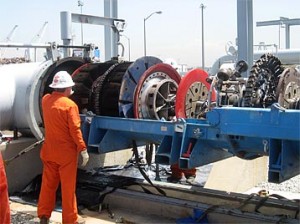
A pipeline worker inspects a “smart pig.” Photo courtesy Pacific L.A. Marine Terminal.
As early as 1926, U.S. Navy researchers had investigated the use of gamma-ray radiation to detect flaws in welded steel. In 1944, Cormack Boucher patented a “radiographic apparatus” suitable for many large pipelines. Modern inspection tools employ magnetic particle, ultrasonic, eddy current, and other methods to verify pipeline and weld integrity.
October 23, 1970 – LNG powers World Land Speed Record
Liquefied natural gas (LNG) powered the Blue Flame to a new world land speed record of 630.388 miles per hour. A rocket motor combining LNG and hydrogen peroxide fueled the 38-foot, 4,950-pound Blue Flame, which set the record at the Bonneville Salt Flats in Utah. The rocket motor could produce up to 22,000 pounds of thrust — about 58,000 horsepower.

In 1970, the Blue Flame achieved, “the greenest world land speed record set in the 20th century.”
Sponsored by the American Gas Association (AGA) and the Institute of Gas Technology, the Blue Flame design came from three Milwaukee, Wisconsin, automotive engineers: Dick Keller, Ray Dausman, and Pete Farnsworth. Building a record-setting rocket dragster in 1967 got the attention of AGA executives.

The American Oil & Gas Historical Society interviewed Dick Keller in 2013 to help produce a YouTube video using his 8mm home movies.
Interviewed by the American Oil & Gas Historical Society in 2013, Keller explained how the growing environmental movement of the late 1960s encouraged AGA “suits” to see value in supporting a new racer fueled by LNG. Keller in 2020 published Speedquest: Inside the Blue Flame, noting natural gas powered “the greenest world land speed record set in the 20th century.”
Learn more in Blue Flame Natural Gas Rocket Car.

October 25, 1929 – Cabinet Member guilty in Teapot Dome Scandal
Albert B. Fall, appointed Interior Secretary in 1921 by President Warren G. Harding, was found guilty of accepting a bribe while in office, becoming the first cabinet official in U.S. history to be convicted of a felony. An executive order from President Harding had given Fall full control of the Naval Petroleum Reserves.
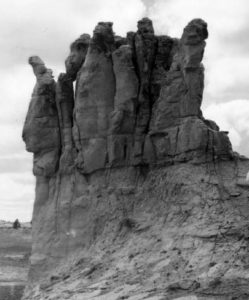
Wyoming’s Teapot Dome oilfield was named after Teapot Rock, seen here circa 1922 (the “spout” later fell off). Photo courtesy Casper College Western History Center.
Fall was found guilty of secretly leasing the Navy’s oil reserve lands to Harry Sinclair of Sinclair Oil Company and to Edward Doheny, discoverer of the Los Angeles oilfield.
The noncompetitive leases were awarded to Doheny’s Pan American Petroleum Company (reserves at Elk Hills and Buena Vista Hills, California), and Sinclair’s Mammoth Oil Company (reserve at Teapot Dome, Wyoming). Fall received more than $400,000 from the two oil companies.
It emerged during Senate hearings that cash was delivered to Secretary Fall in a Washington, D.C., hotel. He was convicted of taking a bribe, fined $100,000, and sentenced to one year in prison. Sinclair and Doheny were acquitted, but Sinclair spent six-and-a-half months in prison for contempt of court and the U.S. Senate.
October 26, 1970 – Joe Roughneck Statue dedicated in Texas
Texas Governor Preston Smith dedicated a “Joe Roughneck” memorial in Boonsville to mark the 20th anniversary of a giant natural gas field discovery in East Texas.
In 1950, the Lone Star Gas Company Vaught No. 1 well discovered the Boonsville field, which produced 2.5 billion cubic feet of natural gas over the next 20 years. By 2001 the field reached production of 3.1 trillion cubic feet of gas from more than 3,500 wells.
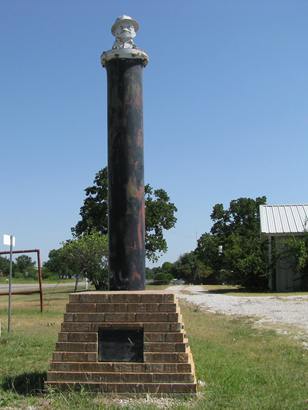
“Joe Roughneck” in Boonsville, Texas. Photo, courtesy Mike Price.
Joe Roughneck began as a character in Lone Star Steel Company advertising in the 1950s. Until discontinued in 2020, the bronze bust was presented each year during the Chief Roughneck Award ceremony of the Independent Petroleum Association of America (IPAA).
In addition to the Boonsville monument, Joe’s bust sits atop three different Texas oilfield monuments: Joinerville (1957), Conroe (1957) and Kilgore (1986).
Learn more in Meet Joe Roughneck.

October 27, 1763 – Birth of Pioneer American Geologist
William Maclure, who would become a renowned American geologist and “stratigrapher,” was born in Ayr, Scotland. He created the earliest geological maps of North America in 1809 and later earned the title, “Father of American Geology.”
After settling in the United States in 1797, Maclure explored the eastern part of North America to prepare the first geological map of the United States. His travels from Maine to Georgia in 1808 resulted in the map’s sequence of rock layers.
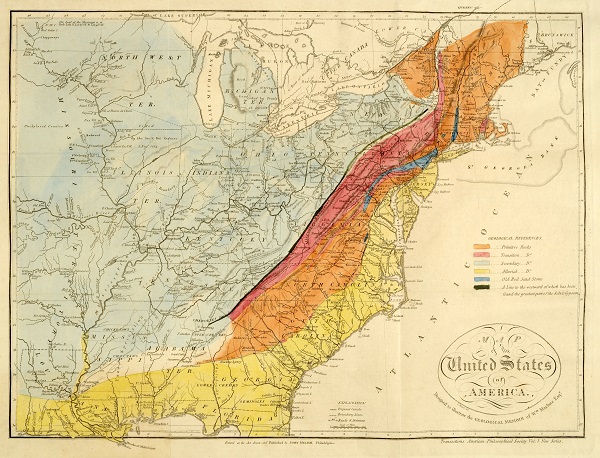
“Map of the United States of America, Designed to Illustrate the Geological Memoir of Wm. Maclure, Esqr.” This 1818 version is more detailed than the first geological map he published in 1809. Image courtesy the Historic Maps Collection, Princeton Library.
“Here, in broad strokes, he identifies six different geological classes,” a Princeton geologist reported. “Note that the chain of the Appalachian Mountains is correctly labeled as containing the most primitive, or oldest, rock.”
In the 1850s, a chemist at Yale analyzed samples of Pennsylvania “rock oil” for refining into kerosene; his report led to the drilling of the first U.S. oil well in 1859 (also see Rocky Beginnings of Petroleum Geology).
October 27, 1923 – Refining Company founded in Arkansas
Lion Oil Company was founded as a refining Company in El Dorado, Arkansas, by Texan Thomas Harry Barton. He earlier had organized the El Dorado Natural Gas Company and acquired a 2,000-barrel-a-day refinery in 1922.

Founded in 1923 in El Dorado, Arkansas, Lion Oil will operate about 2,000 service stations in the south in the 1950s. Photo courtesy Lion Oil.
Production from the nearby Smackover oilfield helped the Lion Oil Refining Company’s refining capacity grow to 10,000 barrels a day. By 1925, the company acquired oil wells producing 1.4 million barrels of oil. A merger with Monsanto Chemical in 1955 brought the gradual disappearance of the once familiar “Beauregard Lion” logo.
Learn more Arkansas history in Arkansas Oil and Gas Boom Towns.

October 27, 1938 – DuPont names Petroleum Product Nylon
DuPont chemical company announced that Nylon would be the name of its newly invented synthetic fiber yarn made from petroleum. Discovered in 1935 by Wallace Carothers at a DuPont research facility, nylon is considered the first commercially successful synthetic polymer. Carothers would become known as the father of the science of man-made polymers (see Nylon, a Petroleum Polymer).
_______________________
Recommended Reading: Oil in West Texas and New Mexico (1982); The Salt Creek Oil Field: Natrona County, Wyoming, 1912
(1982); The Salt Creek Oil Field: Natrona County, Wyoming, 1912 (2017); Oil and Gas Pipeline Fundamentals
(2017); Oil and Gas Pipeline Fundamentals (1993); The Reluctant Rocketman: A Curious Journey in World Record Breaking
(1993); The Reluctant Rocketman: A Curious Journey in World Record Breaking (2013); Speedquest: Inside the Blue Flame (2020); The Bradford Oil Refinery, Pennsylvania, Images of America
(2013); Speedquest: Inside the Blue Flame (2020); The Bradford Oil Refinery, Pennsylvania, Images of America 2006); Early Louisiana and Arkansas Oil: A Photographic History, 1901-1946
2006); Early Louisiana and Arkansas Oil: A Photographic History, 1901-1946 (1982); Du Pont Dynasty: Behind the Nylon Curtain
(1982); Du Pont Dynasty: Behind the Nylon Curtain (1984). Your Amazon purchase benefits the American Oil & Gas Historical Society. As an Amazon Associate, AOGHS earns a commission from qualifying purchases.
(1984). Your Amazon purchase benefits the American Oil & Gas Historical Society. As an Amazon Associate, AOGHS earns a commission from qualifying purchases.
_______________________
The American Oil & Gas Historical Society (AOGHS) preserves U.S. petroleum history. Please become an AOGHS annual supporter and help maintain this energy education website and expand historical research. For more information, contact bawells@aoghs.org. Copyright © 2024 Bruce A. Wells. All rights reserved.












(1956); Where it all began: The story of the people and places where the oil & gas industry began: West Virginia and southeastern Ohio
(1994); Oil And Gas In Oklahoma: Petroleum Geology In Oklahoma
(2013); Kettles and Crackers – A History of Wyoming Oil Refineries
(2016); Utah Oil Shale: Science, Technology, and Policy Perspectives
(2016); George P. Mitchell: Fracking, Sustainability, and an Unorthodox Quest to Save the Planet (2019); Sour Lake, Texas: From Mud Baths to Millionaires, 1835-1909
(1995); Rigs-to-reefs: the use of obsolete petroleum structures as artificial reefs
(1987); Plastic: The Making of a Synthetic Century Hardcover
(1996); American Fads
(1985). Your Amazon purchase benefits the American Oil & Gas Historical Society. As an Amazon Associate, AOGHS earns a commission from qualifying purchases.













